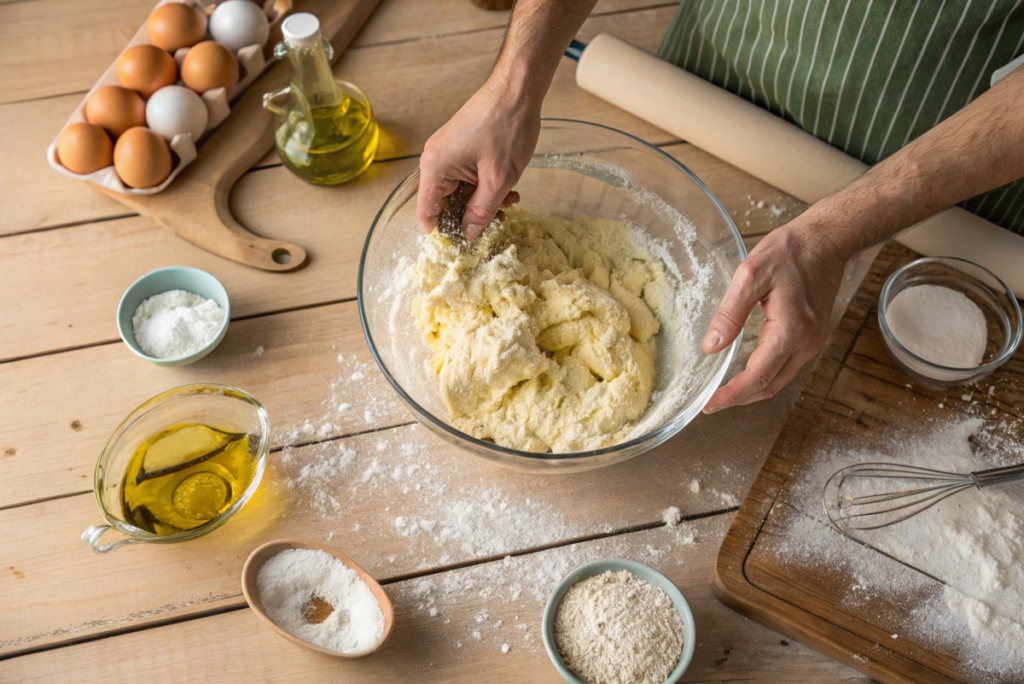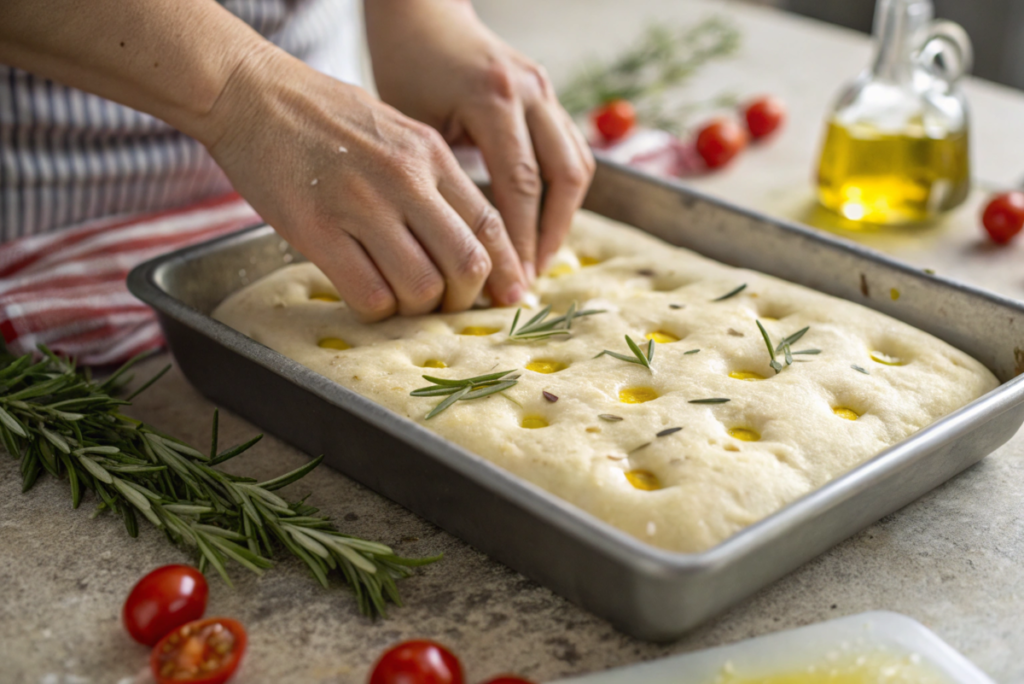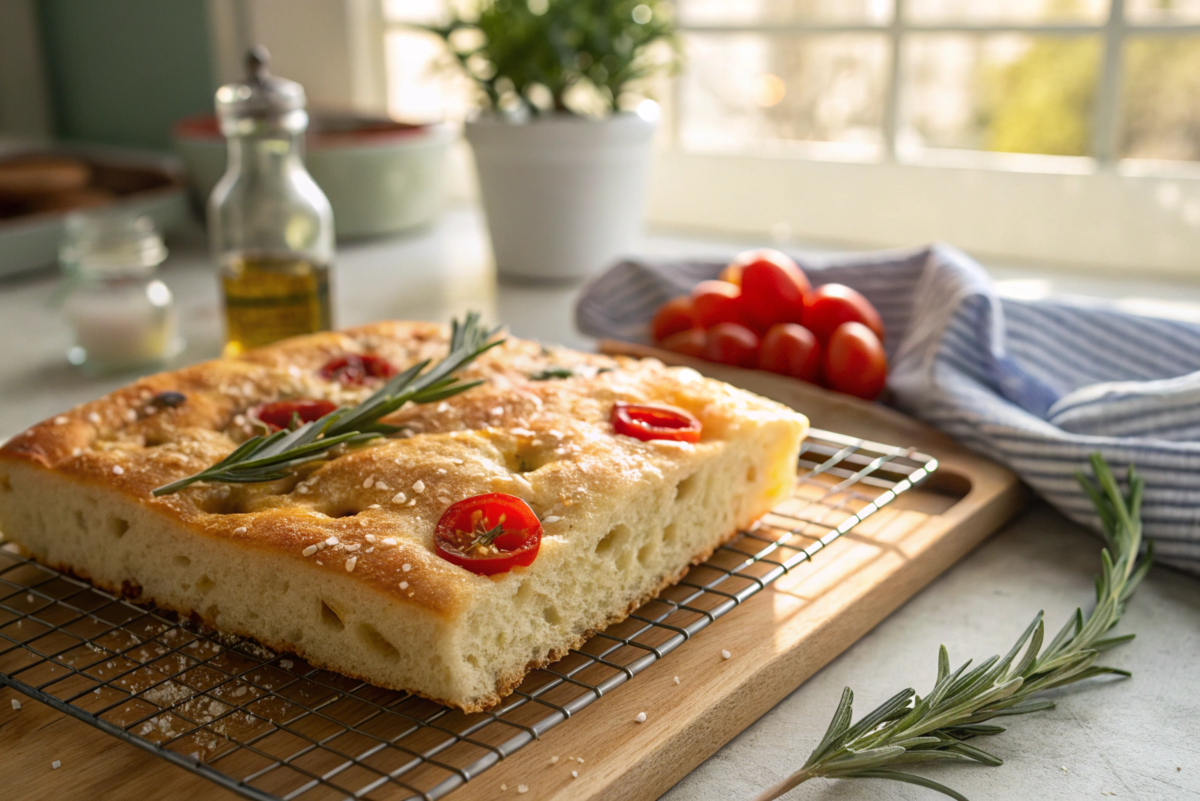Introduction
Have you ever wondered what to do with the leftover sourdough starter after feeding it? Well, you’re not alone! Instead of throwing it away, why not transform it into delightfully airy and golden focaccia bread? This article will take you through every step of the process—from understanding sourdough discard to baking and serving a masterpiece. Whether you’re a beginner or a seasoned baker, this guide will help you make the most of your sourdough discard and create a bread that’s not only delicious but also resourceful. Let’s dive in!
Table of Contents
Understanding Sourdough Discard Focaccia Bread
What is Sourdough Discard?
Sourdough discard is the portion of the sourdough starter you remove before feeding it with fresh flour and water. Typically, it’s tossed out to maintain a healthy balance in the starter. But hold on—don’t waste it! This “discard” is rich in flavor, packed with beneficial microbes, and can be repurposed in various recipes, like sourdough discard focaccia bread.
Not only does sourdough discard prevent waste, but it also adds a tangy flavor to baked goods. Its high hydration content makes it ideal for creating that soft, pillowy focaccia texture you crave. Incorporating sourdough discard is an eco-friendly way to honor the effort you’ve already invested in maintaining your starter.
The Origins of Focaccia Bread
Focaccia, one of Italy’s oldest breads, dates back to ancient Roman times. Known as “Panis focaccias,” this flatbread was cooked over an open fire, evolving into the savory bread we enjoy today. Its hallmark features include airy texture, olive oil richness, and dimples created by pressing fingertips into the dough before baking.
While traditional focaccia relies on yeast, incorporating sourdough discard lends a unique twist. This version balances the traditional Italian approach with the complexity of sourdough fermentation. It’s a match made in culinary heaven!
Benefits of Using Sourdough Discard in Focaccia
Why should you discard sourdough in focaccia bread? The advantages go far beyond just reducing waste:
- Enhanced Flavor: The tanginess of the discard enriches the flavor profile, giving the focaccia a subtle sour note that complements its buttery, savory taste.
- Soft, Chewy Texture: The natural fermentation properties of the discard improve the dough’s elasticity and crumb structure.
- Eco-Friendly Baking: Repurposing discard reduces food waste and maximizes the utility of your sourdough starter.
- Cost-Effective: Utilizing what you already have, relying on additional yeast or flavor enhancers.
Ingredients and Preparation
Essential Ingredients for Sourdough Discard Focaccia Bread
To make sourdough discard focaccia bread, you’ll need a few key ingredients that work harmoniously to create its signature flavour and texture. Here’s what you’ll require:
- Sourdough Discard: The star of the show! This brings a mild tanginess and moisture to the dough. Ensure your discard is fresh (no more than a week old) for the best results.
- All-Purpose Flour: A versatile option that provides the right balance of protein and structure for a soft yet chewy crumb.
- Water: Hydration is crucial in focaccia dough to achieve that airy texture.
- Olive Oil: Not just for flavor but also for creating a golden crust. High-quality extra virgin olive oil works best here.
- Salt: Enhances the natural flavors and balances the tanginess of the sourdough discard.
- Yeast: While sourdough discard adds flavor, a small amount of commercial yeast ensures a reliable rise.
- Optional Toppings: Think rosemary, cherry tomatoes, or flaky sea salt—customize to suit your taste.
Selecting the Right Flour
When it comes to flour, all-purpose flour is the most accessible choice, but bread flour can elevate your focaccia. Bread flour contains more protein, which promotes gluten development and gives a chewier bite. If you’re adventurous, you can experiment with whole wheat or spelled flour, but adjust the hydration to avoid dense results.
Importance of Olive Oil Quality
Olive oil plays a dual role in focaccia—flavoring and preventing sticking. Since it’s a prominent ingredient, go for a high-quality, cold-pressed extra virgin olive oil. Its fruity and slightly peppery notes beautifully complement the tanginess of sourdough discard. Generously oiling the pan and drizzling some over the dough before baking creates that irresistible golden crust.
Role of Salt and Yeast in the Dough
Salt isn’t just a flavor enhancer; it strengthens the dough structure, ensuring an even rise. Use fine sea salt for better incorporation into the dough. As for yeast, even though sourdough discard contributes to fermentation, adding a small amount of active dry yeast ensures that the dough rises consistently, especially if your discard isn’t very bubbly.
Step-by-Step Preparation Guide
Making sourdough discard focaccia bread requires patience and care. Let’s walk through the process:

Mixing the Dough
Mix the sourdough, water, yeast, and olive oil in a bowl. Gradually add flour and salt, stirring until a shaggy dough forms. Avoid over-mixing at this stage; you’re aiming for a sticky consistency. Cover the bowl with a damp towel and rest for 30 minutes.
Fermentation and Proofing
After the initial rest, perform a series of gentle stretch-and-folds every 30 minutes for about two hours. This technique strengthens the gluten and develops the dough’s structure without kneading. Once done, cover the dough and let it proof at room temperature for 4-6 hours or until it doubles in size.
If you prefer overnight proofing, place the dough in the refrigerator. The slow fermentation deepens the flavor while giving you flexibility in your schedule.
Shaping and Dimpling the Dough
Generously oil a baking pan, then transfer the dough into it. Gently spread it out using your fingertips, pressing into the dough to create dimples. These dimples give focaccia its iconic look and help hold toppings like olive oil, herbs, and tomatoes. Cover and let it rest for 30 minutes to an hour for the final rise.
Baking and Serving
Baking the Perfect Sourdough Discard Focaccia Bread

The moment of truth arrives when your dough transforms into a golden masterpiece in the oven. Baking sourdough discard focaccia bread isn’t just about heat; it’s an art that requires attention to detail. Here’s how to do it right:
Oven Settings and Timing
Preheat your oven to 450°F (232°C) at least 30 minutes before baking. This ensures the oven is evenly heated, essential for a consistent bake. Place your pan on the middle rack for even air circulation.
Bake the focaccia for 20–25 minutes, keeping a close eye after 20 minutes. The edges should turn golden brown, and the top should have a crispy, dimpled crust. If you like a slightly deeper crust, leave it in for another 3–5 minutes, but avoid overbaking, as it can dry out the bread.
Achieving the Desired Crust and Texture
The hallmark of focaccia is its contrast between the crisp crust and soft, airy crumb. To achieve this:
- Generous Oil Application: Drizzle olive oil over the dough before baking, letting it pool in the dimples. This not only adds flavor but also helps the crust crisp up beautifully.
- Steam Enhancement: If your oven allows, spritz a bit of water or place a small dish of hot water inside during the first 10 minutes of baking. This creates steam, which aids in developing that perfect crust while maintaining a tender interior.
- Cooling Down: After baking, remove the focaccia from the pan and place it on a wire rack. Cooling it this way prevents the bottom from becoming soggy.
Serving Suggestions and Pairings
Now that your focaccia is baked to perfection, let’s discuss how to serve it. This versatile bread pairs wonderfully with various dishes or is a satisfying snack.
Ideal Accompaniments
Sourdough discard focaccia bread shines when served alongside:
- Soups and Stews: Its airy texture is perfect for soaking up broths or hearty gravies.
- Salads: Pair it with fresh greens, a drizzle of balsamic vinegar, and olive oil for a Mediterranean flair.
- Dips and Spreads: Serve with hummus, olive tapenade, or whipped feta for a snack that’s hard to resist.
Creative Topping Ideas
Why stop at plain focaccia when you can get creative? Before baking, top your dough with any of the following:
- Herbs: Fresh rosemary or thyme adds an aromatic kick.
- Vegetables: Cherry tomatoes, caramelized onions, or thinly sliced zucchini bring flavor and color.
- Cheese: Grated Parmesan or crumbled feta melts beautifully during baking.
- Flaky Sea Salt: Sprinkle a generous pinch on top for a savory finish that enhances every bite.
Troubleshooting and FAQs
Common Issues and Solutions
Baking sourdough and discarding focaccia bread is a rewarding process, but it’s not without challenges. If things don’t go as planned, don’t worry! Here are the most common issues bakers encounter and how to fix them:
Dense or Gummy Texture
A dense or gummy focaccia can be disappointing, but it’s usually due to one of the following reasons:
- Underproofed Dough: If the dough hasn’t risen enough, it won’t have the airy crumb you want. Ensure the dough doubles in size during proofing and feels slightly springy when touched.
- Improper Baking: Pulling the focaccia out too soon can leave the center undercooked. Always check that the crust is golden brown and that the bottom sounds hollow when tapped.
- Low Hydration: Focaccia dough should be wet and sticky. Resist the urge to add too much flour, compromising the texture.
Insufficient Rise
If your focaccia dough doesn’t rise well, here are potential culprits:
- Inactive Yeast: Ensure your yeast is fresh and activated in warm water (not hot!) before use.
- Weak Sourdough Discard: If your discard is too old or inactive, it won’t contribute much fermentation power. Use fresh discard or combine it with a small amount of yeast.
- Cold Environment: Dough rises best in a warm, draft-free area. If your kitchen is cool, place the dough near a warm spot like an oven with just the light on.
Overly Crispy or Burnt Crust
A crispy crust is ideal, but burnt edges can ruin the experience. Avoid this by:
- Oiling the Pan Generously: This helps prevent the bottom from sticking or scorching.
- Monitoring Bake Time: Set a timer and check on the focaccia a few minutes early. Every oven behaves differently!
- Using Parchment Paper: If you notice excessive browning, line your pan with parchment to reduce direct heat.
Frequently Asked Questions
Here are some of the most common questions about making sourdough discard focaccia bread, answered to make your baking journey easier:
Can I use whole wheat flour for sourdough and discard focaccia bread?
Absolutely! Whole wheat flour adds a nutty flavour and enhances the bread’s nutritional profile. However, it absorbs more water, so adjust the hydration by adding slightly more water to maintain the sticky consistency.
How should I store leftover focaccia bread?
Focaccia is best enjoyed fresh, but you can store it at room temperature for up to 2 days in an airtight container. For longer storage, wrap it tightly in foil and freeze it. Reheat frozen focaccia in the oven at 350°F (175°C) to revive its crispy crust.
Can I freeze sourdough and discard focaccia bread?
Yes! Focaccia freezes beautifully. Slice it into portions, wrap them in plastic or foil, and place them in a freezer-safe bag. It can last up to 3 months. When ready to eat, thaw it at room temperature and warm it in the oven for a fresh-out-of-the-oven experience.
What are some popular toppings for focaccia?
The possibilities are endless! Classic options include fresh rosemary, cherry tomatoes, caramelized onions, and olives. Try roasted garlic, artichoke hearts, or thinly sliced sweet potatoes for a modern twist.
How do I know when the focaccia is fully baked?
The focaccia is done when the top is golden brown, the edges are crisp, and the bottom sounds hollow when tapped. You can also check the internal temperature with a thermometer—it should read 190°F to 200°F (88°C to 93°C).
Can I make focaccia without yeast?
Yes! If your sourdough discard is active and bubbly, it can be the sole leavening agent. However, proofing may take longer, as the fermentation relies solely on the natural activity of your starter.

